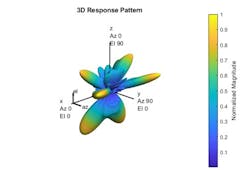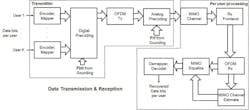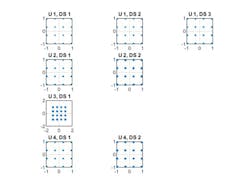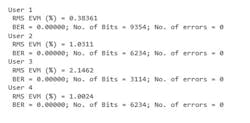I would like to build on my previous blog discussions related to hybrid beamforming, but this time I will look at how hybrid beamforming can be implemented in a massive-MIMO system. To start with, I will focus on hybrid beamforming at the transmit end of a massive-MIMO communications system, including techniques for both multi-user and single-user systems. We can then partition the resulting precoding weights into digital baseband and analog RF components, using different techniques for multi-user and single-user systems.
Multi-user MIMO systems improve the spectral efficiency by allowing a base-station transmitter to communicate simultaneously with multiple mobile receivers using the same time frequency resources. With massive-MIMO systems, the number of base-station antenna elements can be on the order of hundreds to achieve the array gain needed to offset propagation losses at millimeter-wave (mmWave) frequencies. The number of data streams in a cell also increases accordingly.
In a massive-MIMO system, it becomes much more expensive to provide one transmit-receive (TR) module, or an RF chain, for each antenna element. Hybrid transceivers enable a practical solution because they use a combination of analog beamformers in the RF and digital beamformers in the baseband domains, with fewer RF chains than the number of transmit elements.
For a spatially multiplexed system, availability of channel information at the transmitter allows for precoding to be applied to maximize the signal energy in the direction and channel of interest. Assuming a slowly varying channel, the base station sounds the channel by applying a reference transmission used by the mobile receiver to estimate the channel. The mobile system transmits the channel estimate information back to the base station to calculate the precoding weights needed for the subsequent data transmission.
Figure 1 shows the processing for the channel sounding.
1. Shown is a channel sounding model.
Using the orthogonal-matching-pursuit (OMP) algorithm for a single-user system and the joint-spatial-division-multiplexing (JSDM) technique for a multi-user system, we can determine the digital baseband and RF analog precoding weights for a given system configuration. The results were obtained for a system configuration with four users, where the users have a specific number of data streams [3 2 1 2]. The system also includes 64 Tx antennas and 32 Rx antenna elements.
The array response pattern in Figure 2 shows distinct data streams represented by the stronger lobes. These lobes indicate the spread or separability achieved by beamforming.
2. In this array response for a multi-user system, the lobes indicate the spread achieved by beamforming.
The processing in the system includes channel coding, bit mapping to complex symbols, splitting of the individual data stream to multiple transmit streams, baseband precoding of the transmit streams, OFDM modulation with pilot mapping, and RF analog beamforming for all of the transmit antennas employed.
Processing for the data transmission and reception modeled is shown in Figure 3.
3. System processing for transmit and receive in a MIMO system is depicted in this block diagram.
For the MIMO system modeled with the previously described configuration, Figure 4 shows the displayed receive constellation of the equalized symbols. This provides a qualitative assessment of the reception. The actual bit error rate is obtained by comparing the actual transmitted bits with the received decoded bits per user.
4. The receive constellation for a MIMO system provides a qualitative assessment of the reception.
The example in the link below provides a nice starting point to explore the use of hybrid beamforming for multi-user MIMO-OFDM systems. Although the example is based on a specific system configuration, you can explore different system configurations for other channel models. You can also change system-wide parameters like the number of users, number of data streams per user, number of transmit/receive antenna elements, and array locations.
Have more questions? Email me at [email protected].
Learn more about the topics covered in this blog post:
- Massive MIMO Hybrid Beamforming (Example): See how hybrid beamforming is employed at the transmit end of a massive-MIMO communications system, using techniques for both multi-user and single-user systems. Vary the parameters of the system configurations.
See additional 5G, radar, and EW resources, including those referenced in previous blog posts.






